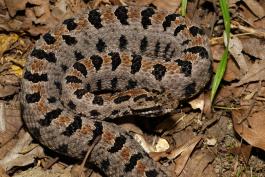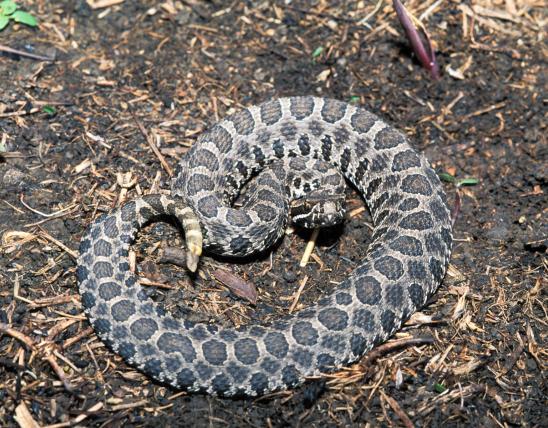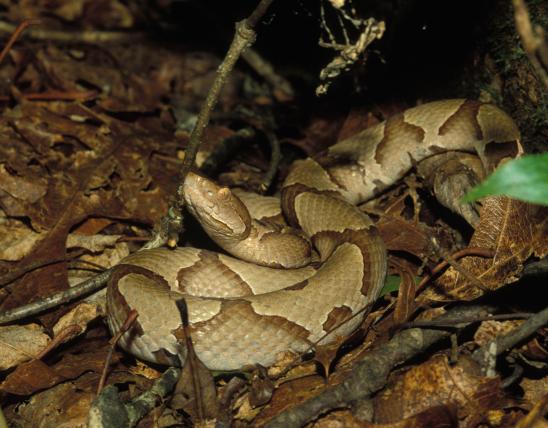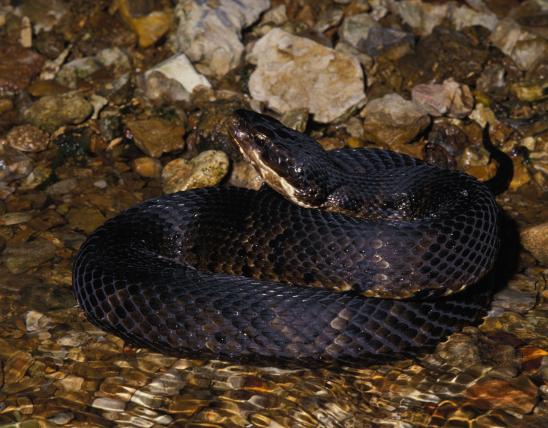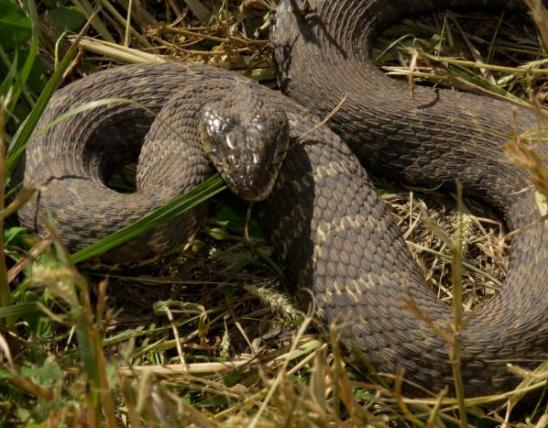
The western pygmy rattlesnake is a small, colorful rattlesnake with a slender tail and tiny rattle. This is one of the smallest species of rattlesnake in North America. Its general color is brownish gray with small dark brown or black blotches. There are 20–30 dorsal blotches, which are round or in short bars. There are one or two alternating rows of small, rounded, dark blotches along the sides. A narrow orange-brown dorsal stripe is usually present. The head has a distinct black stripe that angles from the eye to the corner of the mouth and a sensory pit (heat-sensing pit) located between each nostril and eye. The slender tail has 6–8 dark bands and terminates in a small rattle. Its belly is dusky cream colored with numerous dark, irregularly spaced transverse bars. The scales along the back and sides are keeled, and the anal plate is single.
The disposition of this rattlesnake varies from individual to individual. Some will try to defend themselves vigorously by coiling, sounding their rattles, jerking their head, and striking at any movement. Others remain motionless and try to escape only when touched by a stick or snake hook. The sound of the vibrating rattle is a faint buzz, like the sound of a grasshopper, and can be heard for only about a yard away.
Similar species: Three other rattlesnakes are known from Missouri. The timber rattlesnake (Crotalus horridus) occurs statewide; adults are 3 to 5 feet long and have large rattles. Our other two rattlesnakes are massasaugas; they are rare and only found in northern Missouri.
Length: typically 15 to 20 inches; possibly up to 33 inches. This is one of the smallest species of rattlesnakes in North America.

Extreme southern Missouri along the border with Arkansas, and in the eastern Missouri Ozarks and St. Francois Mountains.
Habitat and Conservation
In Missouri, the western pygmy rattlesnake is most often observed in or near glades, in second-growth forests near rock ledges, and along the area between forests and open lands. Its preferred habitat is south-facing, rocky, and partially wooded hillsides.
During spring, early summer, and autumn, this species usually takes shelter under rocks, logs, brush piles, or shrubs.
For winter dormancy, in the Ozarks this species likely uses animal burrows, logs and stumps, large rocks, and crevices within rock ledges.
During late spring and early summer this small snake will bask in rocky, open areas, near brush piles, or along the side of roads near forests and glades. During July and August this species tends to be nocturnal and can be observed crossing roads and highways at night.
Food
Food includes a variety of lizards, small snakes, mice, and occasionally small frogs and insects.
Like other rattlesnakes, western pygmy rattlesnakes have hollow fangs to inject venom into their prey, and heat-sensitive pits between the eyes and nostrils that allow them to detect and accurately strike warm-blooded prey (such as rodents) even in total darkness.
Juveniles are known to wave their yellow-tipped tail to lure frogs and lizards close enough to kill and eat.
Status
This venomous snake is rarely encountered and very few individuals have been bitten by this species in Missouri. Even though this snake is small and rarely bites people, its venom is quite toxic. They should be respected and left alone.
Life Cycle
This species is normally active from early April to mid-October. Courtship and breeding apparently occur in late summer and early autumn but could happen in early spring after emergence from wintering sites. and young are born from late August through September, with usually 3–7 young per litter. Newborns are paler than the adults, have a yellow tail tip, and are about 5 inches long. Females have been reported to defend their newborns by positioning themselves between the young and the threat. In our state, it appears that females typically only breed every other year. This species may live to be at least 16 years old.
Human Connections
This small species is so secretive that few people encounter it. Although its bite is not fatal, a bite victim should seek immediate medical attention. The western pygmy rattlesnake should be respected and left alone.
In extreme southern Missouri, some people call this snake the “ground rattler.”
Missouri's venomous snakes are dangerous to people and should be avoided. Even freshly killed specimens can inflict a dangerous bite due to reflex action. A local or regional American Red Cross office can furnish up-to-date information on venomous snakebite first aid. In the event of a snakebite caused by a venomous species, the victim should be transferred to a hospital emergency room as soon as possible. Most bites occur when people are trying to kill or handle venomous snakes.
Accidental bites can be avoided by staying away from areas where there may be a concentration of venomous snakes.
- Wear protective footwear in habitats where dangerous snakes may occur.
- Never place your hands under rocks or logs, and do not step over rocks or logs. Step on them first, then over.
- When walking in a forest, step lively.
- Look the ground over when you stop to stand or sit, particularly around large rocks or logs.
- Pit vipers are most active in late evening and at night; be extra careful during these times.
- Finally, avoid any snake you cannot identify.
Most species of venomous snakes are shy and normally avoid people. When encountered in the wild, they usually try to escape detection by remaining motionless. Often, an individual that is provoked will try to escape rather than defend itself. Once cornered, however, these snakes will do their best to defend themselves. Learning to distinguish venomous from nonvenomous species by their color and pattern is recommended.
Ecosystem Connections
Rattlesnakes are considered the most evolutionarily advanced group of snakes. In addition to hollow fangs and heat-detecting facial pits, their tail rattles warn would-be predators not to attack them, saving the snake from having to bite and the enemy from being bitten. But rattlesnakes are often preyed upon by hawks, kingsnakes, and other predators.

